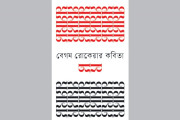Major boost in tourism expected once Ctg-Cox’s Bazar railway rolls out
UNB, Dhaka: The government wants to connect Chattogram and Cox’s Bazar through a railway network to facilitate the movement of tourists but the crucial project taken in this regard has got stuck in limbo due to the Covid-19 pandemic, officials say.
They hope that a direct railway connection with Cox’s Bazar may change fortunes in the beach town as tourists always want to reach their destinations without hazards for their perfect vacationing.
Once completed, the officials said, the 102-km new dual gauge single railway line from Dohazari to Cox’s Bazar will provide “pleasurable and relaxing” journeys for travelers, and this in turn will boost the economy along the railway alignment.
The Tk 18,035-crore project, designated by the government as one of the top 10 priority projects in Bangladesh, is being implemented in two lots.
China Civil Engineering Construction Corporation (CCECC) is implementing the Lot-2 (Chakaria to Cox’s Bazar) of the project together with Bangladesh joint venture partner MAX Infrastructure Limited, while China Railway Group Ltd (CREC) and Toma Construction JV are implementing Lot-1 (from Dohazari to Chakaria).
“The progress of the project is so far 62 percent,” project director and General Manager Md Mofizur Rahman told UNB over the phone.
He said they have already applied to the relevant department for an extension of deadline till June 2023 for the completion of the project.
Rahman said they have sought a one-year extension for the construction work while another year for defect liability detection.
A defects liability period (DLP) is a set period of time after a construction project has been completed during which a contractor has the right to return to the site to fix the defects. A typical defects liability period lasts for 12 months.
By connecting the Cox’s Bazar district with Bangladesh’s railway network, the project will not only boost the national economy through further development of the beach town into a major tourist destination, but also facilitate access for the population and products to subregional markets and trade, said the Asian Development Bank.
The Chittagong-Cox’s Bazar railway corridor is part of the Trans-Asia Railway network. The project has been endorsed by the SASEC trade facilitation and transport working group meeting held in Tokyo on 26 November 2015.
Three Challenges
While talking to UNB at the construction site of the main station in Cox’s Bazar, Project Manager of Construction of New Dual Gauge Railway Line from Dohazari to Cox’s Bazar via Ramu Lot 2 Chen Yongyi said they are facing three major challenges but confident to successfully complete the project.
He identified land handover as the main challenge since more than 1,000 houses need to be demolished to implement the project and things will hopefully be settled within months.
“It’s (land issue) very complicated,” Yongyi, said, adding that the Bangladesh Railway, DC office, and NGOs are dealing with the issues.
Talking about the second challenge, the CCECC official said they find very low ground and heavy rainfalls during monsoon. “We’ve designed so many level-crossings and culverts but due to the wider constructions many people face some issues.”
He finds the impacts of Covid-19 as the third challenge as this affects both their works and lives. “We’re facing difficulties in having more manpower, and also timely supply of construction materials as we had lockdown issues.”
In April 2016, the Executive Committee of the National Economic Council (Ecnec) approved Dohazari-Ramu-Cox’s Bazar and Ramu to Gundum single line dual gauge track construction project (revised) with Tk 18,034.48 crore in a bid to introduce railway communication in the tourist town of Cox’s Bazar.
Initially, there was an instruction from the government to complete the Dohazari-Ramu-Cox’s Bazar portion of the railway track project within the next three years of the project commencement.
Yongyi said the initial deadline for completion of the Lot-2 of the project was February 2021 but the latest deadline is January 31, 2023. “We’ve a very strong collaboration and we’re getting stronger with more trained local staff. We’re confident to complete the Lot-2 works within the deadline.”
Saving time, saving money
Responding to a question, he said the project will save almost 50 percent – be it for delivery of goods or passengers’ travel.
Chen Yongyi said currently it is only the roadway after airways, and it always takes longer time to carry goods and passengers’ travel by road. “And trains are always much safer.”
Responding to a question on train frequency, he said it depends but there will be a direct train from Chattogram to Cox’s Bazar in addition to a train for local travelers which will stop by each station.
Despite the fact that they are facing enormous difficulties during the construction – access to the site, relocation of PGCB, PDB, BREC utilities, tree-cutting permissions at forest areas, on-going Covid-19 pandemic, additional instructed scope of work level crossings, culverts, underpasses and drainage systems, Zhijun said they are in a strong position and together with the Bangladesh Railway and the engineers.
“We’ll continue to take various measures to overcome the problems and complete the works safely and to the specified quality in the shortest achievable time,” he said.
The CCECC has molibilised over 80 expatriate staff from various countries, including the UK, China, India, France and Cambodia.
The majority of these expatriates are from China and currently they have 76 Chinese engineers and management staff.
“It’s our policy to generate employment in Bangladesh and we’ve also recruited over 2,000 local employees to deliver the project,” Yongyi, said.
He said the progress of the work has been severely disrupted by the highly contagious and life-threatening fast-spreading Covid-19 virus.
“We’re continuing with the construction work during the Covid-19 pandemic while maintaining health and safety rules and necessary physical and social distancing as per the guidelines of the Directorate General Health Services, Bangladesh,” said the official.
Non-availability of construction materials, delayed equipment and material deliveries due to abnormal delays at the ports results in a substantial increase in the cost of equipment and materials, he said.
The Asian Development Bank (ADB) and the government of Bangladesh signed an agreement for $400 million in loan on May 23, 2019 to help build a dual- gauge railway connecting Chattogram and Cox’s Bazar to promote trade, investment and tourism in Bangladesh.
The assistance forms the second part of $1.5 billion ADB loans for the SASEC Chattogram-Cox’s Bazar Railway Project.
The new rail link aims to transport 2.9 million passengers annually between Chattogram and Cox’s Bazar by 2024.
The construction of this railway section is one of several ADB railway projects to help Bangladesh meet its targets under its Seventh Five-Year Plan and Railway Master Plan.
“This is something we’ve been hearing for a long time. We can wait for couple of years but good to know that Chattogram is being connected with Cox’s Bazar by rail network which is always a safer mode of transport for me,” Arifujjaman told UNB, noting that he is tired of seeing accidents on roads being a regular traveller of the route.










































































































































































